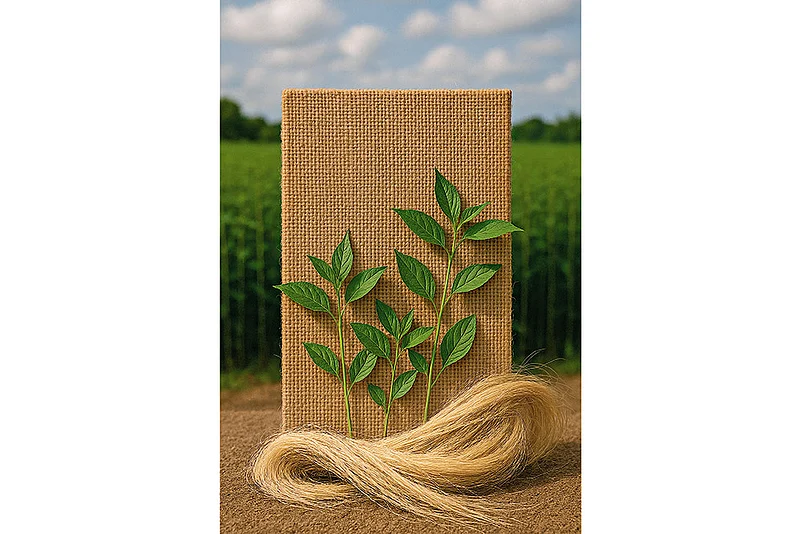The global environment stands at a critical juncture. Plastic pollution, once considered a by-product of modern convenience, has evolved into a pressing environmental catastrophe. Each year, over 400 million tonnes of plastic are produced globally, a significant portion of which ends up polluting oceans, choking landfills, and entering food chains. Single-use plastics – lightweight, disposable, and cheap – are among the worst offenders, taking centuries to decompose while releasing toxic micro-plastics into ecosystems. In this alarming context, the call for sustainable, natural alternatives is not just timely but essential.
World Environment Day, observed every year on June 5th, focuses in 2025 on a fitting theme: “Beating Plastic Pollution.” This theme underscores the urgent need to eliminate plastic dependency and embrace eco-friendly materials. Amid the surge in awareness and innovation, one humble, time-tested crop re-emerges as a beacon of sustainability – jute, India’s golden fibre. With deep roots in Indian agriculture, jute offers not only an environmental antidote to plastic but also socio-economic uplift and cultural continuity.
As the world celebrates World Environment Day 2025 under the banner of “Beating Plastic Pollution,” it is time to look inwards for solutions that are as ancient as they are futuristic. Jute, once a staple of colonial industry, is now a symbol of environmental hope and rural prosperity.
Reviving and mainstreaming jute is not just about replacing plastic. It is about reclaiming indigenous wisdom, empowering communities, and restoring the planet’s health. The road to sustainability runs through our soil – and jute is a fibre that binds ecological integrity with economic justice.
“Jute is not just a crop — it’s a symbol of sustainable living and economic empowerment. Its adoption in our daily lives not only reduces our environmental footprint but also uplifts the rural economy through increased cultivation and artisanal employment. The future is green, and jute is leading the way.” Shashi Bhushan Singh, Secretary, National Jute Board
Jute is not merely a crop. It is a climate solution, a livelihood engine, and a cultural heritage. In the fight against plastic pollution, jute offers India a golden opportunity – an emblem of sustainable resilience waiting to be fully embraced.
Jute: The Sustainable Alternative
Jute, a long, soft, shiny vegetable fibre, has been cultivated in India for centuries, particularly in the Eastern regions. It once held immense economic and strategic importance during British colonial rule, fuelling the famed mills of Bengal. Known for its strength, breathability, and versatility, jute has long been used to make sacks, ropes, mats, and more recently, eco-friendly bags and fashion accessories.
Unlike plastic, which is synthetic, petroleum-based, and non-biodegradable, jute is 100% natural, biodegradable, and compostable. A jute bag discarded today will return to the soil within months, leaving behind no toxic trace. Its durability, once seen as a rival to synthetic fibres, now shines as an asset in the age of sustainable design. While plastics are used once and discarded, jute products are reusable and long-lasting, making them both economically and environmentally viable.
Jute is a true sustainability champion, meeting all three pillars of sustainable development – environmental, economic, and social.

Environmental: Jute cultivation is low-impact. It thrives on natural rainfall and does not require extensive irrigation, synthetic fertilizers, or pesticides. The carbon footprint of growing jute is minimal, and it actually contributes positively to soil health by enhancing fertility through leaf shedding. Moreover, jute plants absorb large amounts of CO₂ and release oxygen at rates far higher than trees of similar mass – making it a net positive for the planet.
Economic: Jute sustains the livelihoods of over 5 million people in India, particularly in states like West Bengal, Bihar, Assam, and Odisha. It supports a broad value chain – from farmers and mill workers to artisans and exporters. Rural and cottage industries based on jute not only preserve traditional crafts but also provide employment in remote and underserved regions.
Social: The jute economy is a significant driver of rural empowerment. Women, especially in weaving and processing clusters, play a key role. Jute-based cottage industries often operate through self-help groups and cooperatives, enabling women to become financially independent while preserving indigenous knowledge systems. For marginalized communities, jute is not just a source of income but a vehicle for dignity and self-reliance.
From Field to Fibre: The Artisan Economy
Jute cultivation is tailor-made for sustainable agriculture. It is a rain-fed, low-cost crop that requires minimal inputs. Indian farmers, especially smallholders, prefer it for its resilience and market value. It grows well during the monsoon and can be rotated with rice, aiding soil regeneration. In states like West Bengal – which contributes over 75% of India’s jute production – the crop plays a vital role in rural livelihoods and ecological balance.
The simplicity of cultivation and its low environmental toll make jute a model for regenerative farming. As climate change threatens traditional farming systems, jute’s adaptability offers hope for both food security and ecological sustainability.
Once harvested and retted (soaked to loosen fibres), jute undergoes an artisanal transformation. Rural clusters across India spin, weave, dye, and stitch jute into a range of products. Artisans craft not just utility items like gunny bags and floor coverings, but also designer bags, home décor, stationery, geotextiles, and fashion accessories that align with contemporary aesthetics.
Women’s cooperatives, particularly in rural Bengal and Assam, are instrumental in this creative process. The revival of handloom jute weaving has not only brought traditional techniques back into vogue but also introduced a new wave of design innovation. The result is a fusion of heritage and modernity – sustainable products with global appeal that rival plastic in both function and form.
Policy and Innovation: The Role of the National Jute Board
The National Jute Board (NJB) plays a critical role in promoting and protecting India’s jute ecosystem. NJB facilitates research and development, quality improvement, marketing, and diversification of jute products. Its training programs equip artisans and entrepreneurs with the skills to innovate and add value to traditional jute crafts.
Through strategic initiatives, the NJB supports product diversification, encouraging the use of jute in packaging, geotextiles (used in soil conservation and road construction), and composites for fashion and interior décor. Importantly, it champions jute as a packaging solution in compliance with environmental mandates like the Plastic Waste Management Rules and the Jute Packaging Materials Act, which mandates jute use in foodgrain and sugar packing.
Jute in the Global Sustainability Conversation
India, as the world’s largest producer of jute, is uniquely positioned to lead a natural fibre revolution. With countries worldwide looking to phase out single-use plastics, the global demand for sustainable, biodegradable alternatives is rising. Indian jute, with its deep heritage and vast production capacity, is ready to meet this demand.
Jute aligns seamlessly with the UN Sustainable Development Goals (SDGs) – particularly those concerning climate action, sustainable economic growth, responsible consumption, and gender equality. By investing in jute, India can not only cut plastic pollution but also boost green jobs and inclusive growth.
























